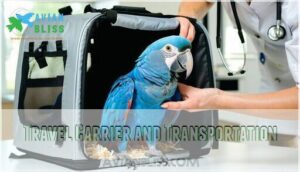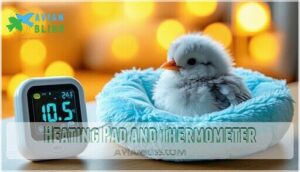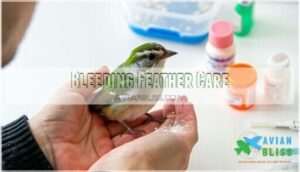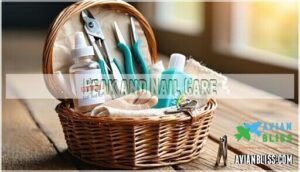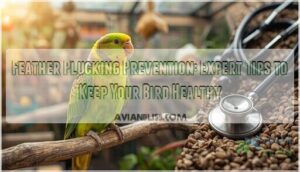This site is supported by our readers. We may earn a commission, at no cost to you, if you purchase through links.
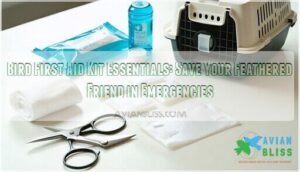
Include wound care materials like gauze, non-stick pads, and medical tape for injuries. Keep styptic powder on hand to stop bleeding from nails or feathers—it’s a game-changer.
Add cleaning essentials like saline solution and antiseptic wipes to safely disinfect minor wounds. Small scissors and tweezers are handy for precise work, while Vet Wrap or self-adhering bandage keeps things secure without sticking to feathers.
Don’t forget a heating pad to stabilize injured birds and a travel carrier for vet visits. A little preparation goes a long way in keeping your feathered buddy safe.
Table Of Contents
- Key Takeaways
- Bird First Aid Essentials
- Emergency Kit Components
- Wound Care and Treatment
- Advanced First Aid Procedures
- Frequently Asked Questions (FAQs)
- What should be in a bird first aid kit?
- What are 10 important items in a first aid kit?
- What is the first aid for birds?
- What do I need to buy for a pet bird?
- What is in a bird first aid kit?
- What is a safe antiseptic for birds?
- What to have in an animal first aid kit?
- How often should a bird first aid kit be checked?
- What should be done if a bird resists treatment?
- Can I use household items as first aid tools?
- Conclusion
Key Takeaways
- Keep styptic powder handy to stop bleeding quickly from nails or feathers in emergencies.
- Use nonstick gauze, vet wrap, and saline solution to clean and secure wounds safely.
- Include a heating pad to stabilize injured birds and a travel carrier for secure transport to the vet.
- Regularly check and restock your bird first aid kit to ensure all supplies are fresh and ready to use.
Bird First Aid Essentials
Having a well-stocked bird first aid kit is essential for responding to injuries quickly and effectively.
With the right supplies, you can manage wounds, control bleeding, and keep your feathered friend safe until you reach a veterinarian, which is crucial for providing effective care.
Wound Care Materials
For effective bird wound care, focus on essentials like gauze pads, vet wrap, and saline solution.
Gauze options help control bleeding, while bird antiseptic solutions disinfect safely. Styptic uses include stopping minor bleeding from feathers or nails.
Healing ointments soothe skin, promoting recovery. You can find specialized bird wound care products online.
A well-stocked kit with versatile bandage materials guarantees you’re ready for emergencies.
Bandage and Wrap Options
Bandage materials like vet wrap, roll gauze, and adhesive tape make wound care manageable.
Vet Wrap’s flexibility lets you secure pressure wraps without sticking to feathers, while gauze pad types—like sterile or nonstick—protect injuries.
For small spots, tape application works best.
You can find specialized bird vet wrap online.
These bandage alternatives offer versatility, ensuring your bird’s treated safely and comfortably, even during unexpected emergencies.
Cleaning and Disinfecting Solutions
Keep your bird safe using topical antiseptics like diluted chlorhexidine or betadine for wound cleaning and disinfection.
For feather cleaning or wound flushing, opt for sterile saline. Always store solutions properly to avoid contamination.
A disinfectant like betadine diluted with saline guarantees gentle bird disinfection. Remember that daily cage cleaning is essential for preventing bacteria buildup.
Stick with safe dilution ratios and focus on thorough yet careful application to protect your feathered friend and ensure daily cage cleaning is part of your routine.
Styptic Powder and Gel
Bleeding emergencies can get messy fast, but styptic powder and gel are lifesavers in your bird first aid kit.
They’re great for bird bleeding control when a feather, nail, or beak bleeds.
Follow these steps for safe usage:
- Apply directly to the bleeding spot.
- Press gently for a few seconds.
- Avoid overuse—it stings!
- Store in a cool, dry place, to ensure the effectiveness of the product.
Emergency Kit Components
Building a reliable emergency kit for your bird guarantees you’re prepared for unexpected situations. From travel carriers to medical supplies, the right tools can make all the difference.
A well-stocked bird emergency kit ensures you’re ready to handle injuries and emergencies with confidence, keeping your feathered friend safe and secure.
Travel Carrier and Transportation
A bird transport carrier is a must for your bird emergency kit. Choose a carrier size that’s comfortable but snug to prevent shifting during transport.
Make certain carrier ventilation keeps airflow steady, reducing stress. Secure transport is key, so use sturdy locks.
During emergency evacuation, keeping a bird emergency carrier handy means safer, faster rescues for your feathered friend.
Remember to watch for labored breathing signs during transport, as this indicates distress.
Food and Water Supplies
You’ve got the travel carrier ready; now stock up on hydration methods and food.
Include hand feeding formula, baby food, and Pedialyte for emergencies.
Use disposable feeding pipettes for precise portions.
Maintain feeding schedules with proper nutritional support.
For water sanitation, pack oral rehydration salts.
Store food in airtight containers to keep it fresh and safe.
Medication and First Aid Kit
Your bird first aid kit essentials should include hydrocortisone cream, sterile saline, and styptic powder for minor injuries.
Kit organization is critical—use labels and store at suitable temperatures to preserve bird medical kit supplies.
Keep track of expiration dates to guarantee safety. Consider the need to purchase bird-specific options for styptic powder.
Dosage calculation for essential medications varies; consult your vet. Don’t forget basic bird health supplies like gauze and disinfectants. Ensure you have all the necessary items, including styptic powder, to provide proper care.
Heating Pad and Thermometer
When assembling your bird emergency kit, grab a heating pad for temperature regulation and hypothermia prevention—it’s a lifesaver.
Use it carefully to avoid overheating risks.
A thermometer is equally important to monitor your bird’s body temperature.
Digital and infrared thermometer types work best.
Together, these bird first aid kit essentials provide comfort and safety during emergencies, ensuring your bird stays warm and stable.
Wound Care and Treatment
When your bird has a wound, quick and proper care is essential to prevent infection and aid healing.
With the right materials and simple techniques, you can handle minor injuries confidently until you can seek veterinary help.
Bleeding Feather Care
Feathers can bleed like open faucets if a blood feather gets damaged.
Here’s how to handle it:
- Apply styptic gel, styptic powder, or cornstarch to stop bleeding quickly.
- Remove a broken blood feather carefully if directed by a vet using proper removal techniques.
- Check regrowth concerns and maintain aftercare tips with clean bandages and bird wound treatment.
To quickly control bird bleeding, apply direct pressure to stop the bleeding.
Open Wound Management
For open wound management, start by using bird wound cleaning products like sterile saline or diluted chlorhexidine to flush debris.
Apply a nonstick pad, secure it with vet wrap, and avoid tight bandages.
Use medications, like antibiotic ointments, advised by a vet to prevent infection.
Regularly check for signs of infection during healing to guarantee proper bird wound care and ensure the wound is healing correctly with the use of antibiotic ointments.
Skin and Feather Injuries
Skin injuries or feather loss can happen unexpectedly.
For bird abrasions or cuts, start with nonstick gauze and bird wound care products like diluted chlorhexidine or aloe vera gel.
Feather plucking and infections might mean deeper issues—check for abscess care and clean affected areas gently.
For burn treatment, cool the skin with sterile saline.
Always monitor for signs of infection.
Beak and Nail Care
Caring for your bird’s beak and nails is like running a miniature manicure salon.
Use tools like a metal nail file for shaping techniques, ensuring beak trimming and nail clipping are safe and smooth.
Nail safe styptic powder helps with injury repair.
Prevent overgrowth with regular maintenance.
Prioritize nail care and beak care to keep your feathered friend healthy and stress-free.
Advanced First Aid Procedures
When a bird faces serious injuries like fractures or breathing problems, knowing how to act quickly can save its life.
Advanced procedures require extra care, proper tools, and guidance from an avian vet to guarantee effective treatment.
Fracture and Break Management
When handling bird fractures, stabilize the wing or leg using proper splinting techniques.
Gently align the bone with bird splinting material like vet tape or gauze.
Cage restriction prevents further injury while supporting the healing timeline.
Pain management is essential—consult a vet for guidance.
Keep bird fracture care tools in your emergency kit for broken bird wings or legs, ensuring you are prepared for emergency situations.
Respiratory and Breathing Issues
When breathing problems strike, quick action can save your bird. Watch for labored breathing or open-mouthed panting. Use sterile saline to clear the nostrils or a syringe for gentle flushing.
Quick action during breathing problems can save your bird—clear nostrils gently and provide a humid, stress-free environment for recovery.
One key step is to stabilize the bird, creating a humid, warm environment away from stressors.
Here’s how you can help:
- Provide Oxygen Therapy with proper airflow.
- Seek avian emergency care for Air Sac Cannulation or Pneumonia Treatment.
- Manage aspiration using careful positioning.
Umbilicus and Vent Care
If your bird looks uncomfortable and you notice swelling or redness near the vent, it could signal Vent Prolapse, Egg Binding, or Cloacal Papillomas.
Keep hygiene practices strict—flush with sterile saline and monitor for changes.
Include lubricants, gauze, and syringes in your bird care essentials.
Fecal scoring helps track health, making your bird first aid kit essentials invaluable for urgent care.
Avian Veterinary Care and Advice
An avian veterinarian isn’t just for emergencies—they’re your partner in keeping your bird happy and healthy.
Build trust through open vet communication, ask about preventative care, medication safety, or specialist referrals.
If post-op care’s needed, follow advice precisely, and regular visits guarantee effective bird veterinary care.
While avian first aid skills prepare you for moments when bird emergency care is vital, following these guidelines ensures you’re well-prepared for any situation, including those requiring bird emergency care.
Frequently Asked Questions (FAQs)
What should be in a bird first aid kit?
Think of it as packing for emergencies: include gauze pads, vet wrap, tweezers, saline, styptic powder, scissors, antiseptic, bandage tape, a towel for restraint, and your vet’s contact info for quick help.
What are 10 important items in a first aid kit?
You’ll want sterile gauze, vet wrap, scissors, saline solution, tweezers, styptic powder, adhesive tape, antiseptic wipes, syringes, and an emergency contact list.
These essentials keep you ready to handle unexpected injuries confidently.
What is the first aid for birds?
Feathers, first aid, and fast action: when treating a bird, stay calm, stabilize it in a quiet space.
Stop bleeding with styptic powder or gauze, clean wounds with diluted saline.
Contact a veterinarian immediately, and remember to stay calm.
What do I need to buy for a pet bird?
You’ll need a sturdy cage, bird-friendly food, perches, toys for mental stimulation, cleaning supplies, and basic first aid items.
Don’t forget a water bowl and a travel carrier for emergencies.
What is in a bird first aid kit?
A well-stocked bird first aid kit includes nonstick gauze pads, vet wrap, styptic powder, tweezers, scissors, saline solution, bandage tape, disinfectants like chlorhexidine, and a heating pad.
Everything you’ll need to handle emergencies swiftly and safely is included in the kit.
What is a safe antiseptic for birds?
An ounce of prevention is worth a pound of cure," so use diluted chlorhexidine or betadine as bird-safe antiseptics.
They’re gentle on delicate skin, effective at cleaning wounds, and help prevent infections without harming feathers, which makes them a good choice for prevention.
What to have in an animal first aid kit?
Pack gauze, bandages, vet wrap, antiseptic wipes, scissors, tweezers, saline, gloves, a thermometer, styptic powder, and a flashlight.
Add your vet’s contact info, a towel, and snacks.
Combine essentials for emergencies and peace of mind.
How often should a bird first aid kit be checked?
Check your bird’s first aid kit every three to six months.
Replace expired items, restock supplies, and make certain everything’s clean and organized.
Staying prepared keeps your feathered friend safe when emergencies come out of the blue.
What should be done if a bird resists treatment?
If your bird resists treatment, gently wrap them in a soft towel to keep them calm and still.
Speak softly, move slowly, and take breaks if needed.
Patience and practice make a big difference!
Can I use household items as first aid tools?
You can use household items like clean towels for restraint, cotton swabs for cleaning, or masking tape to secure bandages.
Just make certain everything is clean and safe to avoid worsening the injury.
Conclusion
Think of your bird first aid kit as a safety net—ready to catch you in moments of crisis.
By including essential items like wound care materials, cleaning solutions, and a heating pad, you’re equipping yourself to handle emergencies with confidence.
Don’t forget staples like styptic powder and a sturdy travel carrier for quick vet visits.
Preparation is key; having bird first aid kit essentials on hand guarantees your feathered friend gets the care they need when it matters most.
- https://www.petmd.com/bird/care/how-stock-first-aid-kit-care-injured-pet-birds
- http://eclectusparrots.net/firstaid.html
- https://www.greatcompanions.com/product/what-to-include-in-your-bird-s-first-aid-kit/?srsltid=AfmBOoos1cDmknLFSd39s-Q79OAa1bVUjVv0Y4TADI9a7a78byNupDm7
- https://www.petco.com/content/content-hub/home/articlePages/health-wellness/basic-first-air-for-pet-birds.html
- https://www.amazon.com/First-Aid-Birds/s?k=First+Aid+For+Birds


